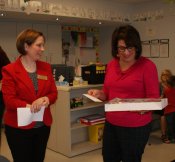Gannon Collaboration Creates Better Crayons for Students
The Barber National Institute and Gannon University unveiled a new adapted crayon created by Gannon students in collaboration with faculty and preschool students at the Elizabeth Lee Black School. The new crayons will help students with physical and intellectual disabilities while also reducing the environmental footprint by keeping broken crayons out of landfills.
The crayon was the culmination of the Integrated Crayons for Adaptive Needs (ICAN) project, a cross-disciplinary, community effort through which the Gannon students and professors worked together to collect used crayons from local elementary schools that were engineered and repurposed into adaptable crayons.
Funded by a mini-grant from the Erie-Gannon Alliances to Improve Neighborhood Sustainability (Erie-GAINS) initiative, the project began when students enrolled in Gannon’s education program engaged local schools in collecting broken and unused crayons over a five month period.
“Crayons were collected, sorted, cleaned and delivered to students enrolled in the engineering program to be melted and molded into useable crayons for preschool students at the Barber National Institute,” stated Nancy Morris, an instructor in Gannon’s School of Education.
Occupational therapists from the Barber Institute met with Morris and Davide Piovesan, Ph.D. assistant professor of biomedical engineering, to discuss a design that would be easier for students with disabilities to use. Dr. Piovesan and students in his Tribology class designed the crayons on a computer program and transferred the design to a machine that made a form that was then used to create silicone molds. “A silicone mold allows for both large and small production where the wax is either melted separately and poured into the mold, or crayons are melted directly into the mold using a microwave oven,” said Dr. Piovesan
One of Piovesan’s students, Ajay Kumar, said it best, “This process can be done whenever, wherever and by whomever.”
Since crayons are made from paraffin, a bi-product of petroleum, the discarded crayons will not break down and leave a waxy sludge in the landfills. The (ICAN) initiative works to recycle these bits and pieces into crayons that will serve a new and innovative purpose.
The crayons, which measure two to three inches in length, have textured sides and a ridge around the center where students can better grip the crayons. Gannon students also created sorting stations where preschool students sorted the crayons while also reinforcing color identifying.
“It was wonderful to have our students involved in the early stages of this project, and now be able to use the finished product,” said Dr. Maureen Barber-Carey. “All students love to color and create art projects in class and alongside their typical peers. These crayons will enable children with disabilities to better grasp and manipulate crayons and more fully enjoy this very essential part of childhood.”
An initial delivery of crayons was presented to a classroom at the Barber Institute, with plans for Gannon students to continue creating the crayons so that all classes will have access to them by the time they return to school in the fall.



